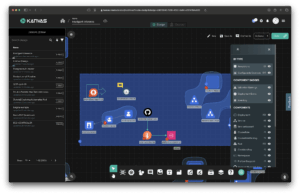Layer5 Debuts Enterprise Edition of Meshery for Configuring Kubernetes
Layer5 today revealed it has made available Kanvas, an enterprise grade distribution of the open source Meshery framework for declaratively managing Kubernetes environments.
Announced at the KubeCon + CloudNativeCon North America 2025 conference, Kanvas adds additional graphical tools to visualize and edit, along with functionality such as the ability to store snapshots in GitHub repositories to a core Meshery platform that provides workspaces that enable IT teams to collaborate more easily. It also provides access to a catalog of hundreds of pre-built, best-practice design patterns and reference architectures that IT teams can extend.
Additionally, Kanvas also makes available role-based access controls (RBAC) and an ability to import existing Kubernetes manifests, Helm charts, Kustomize configuration and Docker Compose files.
Available to be deployed by an internal IT team or access as a managed service, Kanvas today provides a drag-and-drop interface for designing and visualizing complex infrastructure and application architectures using Meshery.
Layer5 is also making available in beta a Kanvas Operator for managing live infrastructure in real-time using a Meshery framework that is currently being advanced under the auspices of the Cloud Native Computing Foundation (CNCF).
Layer5 CEO Lee Calcote said at its core Meshery provides a platform that fosters collaboration in a way that makes it simpler for IT teams to retain tribal knowledge. It allows engineers to see, collaborate on, and approve suggestions on a visual canvas, and even conduct a dry run to validate changes.
In addition to making it simpler to manage Kubernetes clusters at scale, Kanvas also makes it simpler to onboard additional engineers to a team, noted Calcote.
It’s not clear how many Kubernetes clusters are deployed in production environments, but as the number increases, the need for finding ways to manage one of the most complex IT platforms ever created is becoming more acute. There simply are not enough engineers to manage those clusters, so platforms such as Kanvas that make it simpler for small teams to consistently manage the configuration of Kubernetes clusters is crucial, said Calcote.
Hopefully, as various tools make Kubernetes more accessible, organizations will be able to rely more on IT administrators rather than DevOps engineers to manage them. The need for DevOps engineers isn’t likely to be eliminated any time soon, but it should become easier for IT teams to reuse configurations that have already been validated by a DevOps team. In effect, Meshery and Kanvas are making it simpler for IT teams to embrace infrastructure by design principles, noted Calcote.
In the meantime, IT organizations should expect the total number of workloads running on Kubernetes clusters to continue to steadily increase, especially as more artificial intelligence (AI) applications are built and deployed. The challenge, as always, is finding a way to manage large numbers of Kubernetes clusters at higher levels of scale. In fact, arguably there would many more Kubernetes clusters already deployed in the platform if the platform was easier to manage.
Hopefully, there will come a day soon when the inherent complexity of Kubernetes is no longer an issue, but until then, the next best thing is to adopt tools that enable IT teams to manage clusters at a much higher level of abstraction.



